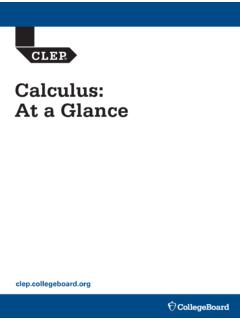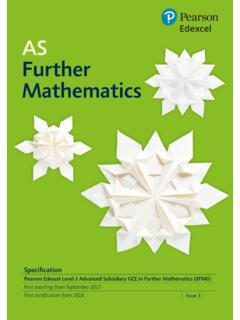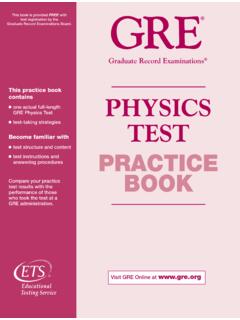Transcription of AP Calculus Practice Exam and Solutions
1 AP Calculus ABPractice ExamCopyright 2015 by Lucid EducationCalculus ABSection 1, Part ATime - 55 minutesNumber of questions - 28A CALCULATOR MAY NOT BE USED ON THIS PART OF THE EXAMD irections: Solve all of the problems that follow. Available space on the page may be used forscratch this exam:(1)The domain of a function in this exam is assumed to be all real numbers for which thefunction is defined, unless specified otherwise.(2)The inverse notation or the prefix arc may be used to indicate an inverse function. For example, the inverse tangent of x may be written as arcsin(x) or as .Section 1, Part ACalculus ABCopyright 2015 by Lucid EducationGo on to the next page1. Using the substitution , the integral is equivalent toA) B) C) D) E) 2.
2 Find .A) B) C) D) E) Section 1, Part ACalculus ABSection 1, Part ACopyright 2015 by Lucid EducationGo on to the next page3. A line through the point (2, -2) is tangent to function f at the point (-2, 6). What is ?A) -8B) -2C) D) 6E) Undefined4. Grain is pouring out of an opening in the bottom of a grain silo. The rate at which the height,h, of the grain in the silo is changing with respect to time, t, is proportional to the square root ofthe height. Which of the following is a differential equation describing this situation?A) B) C) D) E) Section 1, Part ACalculus ABCopyright 2015 by Lucid EducationGo on to the next page5. Where is the graph of concave up?
3 A) B) C) D) E) 6. Shown is a graph of function which value of x is f continuous but not differentiable?A) aB) bC) cD) dE) eSection 1, Part ACalculus ABCopyright 2015 by Lucid EducationGo on to the next page7. The table shows values of , the derivative of function f. Although is continuous over allreal numbers, only selected values of are has exactly two real zeros, then f is increasing over which of the following intervals?A) B) C) onlyD) E) 8.. A) B) C) D) E) Section 1, Part ACalculus ABCopyright 2015 by Lucid EducationGo on to the next page9. At each point (x, y) on a graph of function f, the graph has a slope equal to.
4 If thegraph of f goes through the point (2, 3), then A) B) C) D) E) 10. The derivative of function g is given by . When is g increasing?A) B) C) D) E) Section 1, Part ACalculus ABCopyright 2015 by Lucid EducationGo on to the next page11. Function f is defined as Which of the following statements is true:I. f is continuous at .II. f is differentiable at A) None of the statements are ) I onlyC) II onlyD) I and II onlyE) I, II, and ) B) C) D) E) Section 1, Part ACalculus ABCopyright 2015 by Lucid EducationGo on to the next page13. Shown is a graph of , the second derivative of function.
5 The curve is given by theequation . The graph of has inflection points at which values of x ?A) b onlyB) c onlyC) a and dD) a and cE) d only14. Function f is defined such that for all , the line is a horizontal asymptote. Which of the following must be true?A) is ) for all .C) D) All of the ) None of the 1, Part ACalculus ABCopyright 2015 by Lucid EducationGo on to the next page15. Shown in the diagram is a graph of , the derivative of function . If , then?A) B) C) D) E) 16. A) B) C) D) E) Section 1, Part ACalculus ABCopyright 2015 by Lucid EducationGo on to the next page17. A. B. C.
6 D. E. 18. A) B) C) D) E) Section 1, Part ACalculus ABCopyright 2015 by Lucid EducationGo on to the next page19. Let f be the function defined by . The equation of the line tangent to thegraph of f at isA. B. C. D. E. 20. A) B) C) D) E) 2 Section 1, Part ACalculus ABCopyright 2015 by Lucid EducationGo on to the next page21. A particle s position at any time is given by the equation . At what time is the particle at rest?A) and B) and C) and D) onlyE) only22. Shown is a graph of , the derivative of function of the following statements is true?A) f is not differentiable at.
7 B) f has a local minimum at .C) f is increasing from to .D) f is increasing from to .E) f is decreasing from to .Section 1, Part ACalculus ABCopyright 2015 by Lucid EducationGo on to the next page23. What is the slope the line tangent to the curve at the point (2, 3) ?A) B) C) D) E) 24. A) B) C) D) E) Section 1, Part ACalculus ABSection 1, Part AGo on to the next pageCopyright 2015 by Lucid Education25. Function f is defined by the equation . If and , whatis ?A) B) C) D) E) 26.. Find .A) B) C) D) E) does not 1, Part ACalculus ABCopyright 2015 by Lucid Education27. Function f is a twice differentiable function with and for all realnumbers x.
8 If and , what is a possible value for ?A) 7B) 9C) 12D) 13E) 1728. , , and are all positive for any real number x. Which of the followinggraphs could be a graph of ?A) B) C) D) E)End of Section 1, Part AIf you finish before the time limit for this part, check your work on this part move on to the next part until you are told to by the test 2015 by Lucid EducationCalculus ABSection 1, Part BTime - 50 minutesNumber of questions - 17A GRAPHING CALCULATOR MAY BE REQUIRED TO SOLVE SOME QUESTIONSON THIS PART OF THE EXAMD irections: Solve all of the problems that follow. Available space on the page may be used forscratch work. You may not return to the previous section of the this exam:(1)The domain of a function in this exam is assumed to be all real numbers for which thefunction is defined, unless specified otherwise.
9 (2)The inverse notation or the prefix arc may be used to indicate an inverse function. For example, the inverse tangent of x may be written as arcsin(x) or as .(3)The exact numerical answer for a problem may not be listed as one of the given choices. When this is the case, choose the value that is the closest approximation to exact 1, Part BCalculus ABCopyright 2015 by Lucid EducationGo on to the next page76. The derivative of function f is given by . At what values of x does the graphof f have an inflection point?A. 0B. The graph has no inflection The region in the x-y plane bounded by the lines , , , and is the baseof a solid. Each cross section of the solid perpendicular to the x-axis is a square.
10 The volume ofthe solid isA. 1, Part BCalculus ABCopyright 2015 by Lucid EducationGo on to the next page78. Function f is differentiable and and . Function g is defined as . What is the equation of the line tangent to function g at .A. B. C. D. E. 79. Which could be a graph of f such that ?A. B. C. D. E. Calculus ABSection 1, Part BCopyright 2015 by Lucid EducationGo on to the next page80. The acceleration of a particle moving along the x-axis is given by . At time, the velocity of the particle is 2. What is the velocity at time ?A. Shown are selected values for functions f, g, h, j, and k, all of which are twice differentiablein the closed interval [1, 4].








